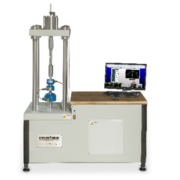Load Cells Versus Piezoelectric Sensors
 Load cells and piezoelectric sensors are used in all types of measurement applications. While both types of sensors are used to measure similar physical quantities, they work on different principles and have distinctive characteristics.
Load cells and piezoelectric sensors are used in all types of measurement applications. While both types of sensors are used to measure similar physical quantities, they work on different principles and have distinctive characteristics.
By simple definition, load cells measure the amount of force or weight being applied to them. The amount of force a load cell is engineered to measure is numerated by the capacity of the model specification and design, such as 50lbf (pounds-force) or 5kN (kilonewton). When a force is applied to the load cell, the metal body deforms slightly, which changes the resistance of the strain gages. This change in resistance is then measured and used to calculate the amount of force being applied to the load cell.
Piezoelectric sensors work on the principle of piezoelectricity. They are made of materials that generate an electric charge in response to mechanical stress, such as pressure or vibration. Piezoelectricity is a property of certain materials that allows them to generate an electric charge in response to applied mechanical stress, such as pressure or vibration. The word “piezo” comes from the Greek word for “squeeze” or “press,” which refers to the fact that these materials generate an electric charge when they are squeezed or pressed. When a force is applied to a piezoelectric sensor, it generates a voltage proportional to the amount of force being applied. This voltage can then be measured and used to calculate the force or weight being measured. Piezoelectric sensors are most often used in vibration and pressure tests.
Load cells are more suitable for applications where high accuracy is required, as they are more sensitive than piezoelectric sensors in detecting smaller changes in force. Load cells are characteristically more robust and can withstand higher loads without being damaged. Piezoelectric sensors, on the other hand, can be more fragile and may require more careful handling to avoid damage.
Load Cell Advantages
- Higher accuracy: Load cells are more accurate than piezoelectric sensors, especially when measuring low loads. Load cells can provide precise and reliable measurements with minimal error, making them ideal for applications that require high accuracy. Read: Specifying Accuracy Requirements When Selecting Load Cells
- Lower sensitivity to temperature changes: Load cells are less sensitive to temperature changes than piezoelectric sensors. This means that load cells can maintain their accuracy even when the temperature changes, while piezoelectric sensors may need to be calibrated frequently to maintain accuracy. Read: Understanding Load Cell Temperature Compensation
- Better linearity: Load cells have a more linear response than piezoelectric sensors, which means that their output is more predictable and easier to calibrate. This is particularly important in applications where accurate and repeatable measurements are critical.
- Higher durability: Load cells are more robust and can withstand higher loads without being damaged. This makes them suitable for applications where high loads are present, such as in heavy machinery or construction.
- Lower cost: Load cells are often less expensive than piezoelectric sensors, making them a more cost-effective choice, especially for OEM use cases.
Piezoelectric sensors are used in a wide range of applications that require the measurement of vibration or acceleration. For example, piezoelectric sensors can be used in machinery and equipment to monitor vibrations and detect potential problems, such as imbalances or misalignments. They are the sensors used in cars to measure pressure, such as in tire pressure monitoring systems or fuel injection systems. Piezoelectric sensors are found in ultrasound imaging to generate and detect sound waves and in musical instruments, such as electric guitars or electronic drum kits, to convert vibrations into electrical signals for amplification.
In selecting the right load cell for any project, check out our new Load Cell Selection Guide. It is a useful resource to determine the capacity, capability and design features that are best suited for your applications. You can also check out How to Choose the Right Load Cell.
Load cells and piezoelectric sensors have distinctive characteristics and advantages, thus specific application requirements will determine the choice of sensor. For questions about selecting the right sensor for your application, contact our solutions engineers.
Additional Resources
Get an Inside Look at Interface’s Famously Blue Load Cells
Load Cell Basics Sensor Specifications
Interface Load Cell Field Guide








